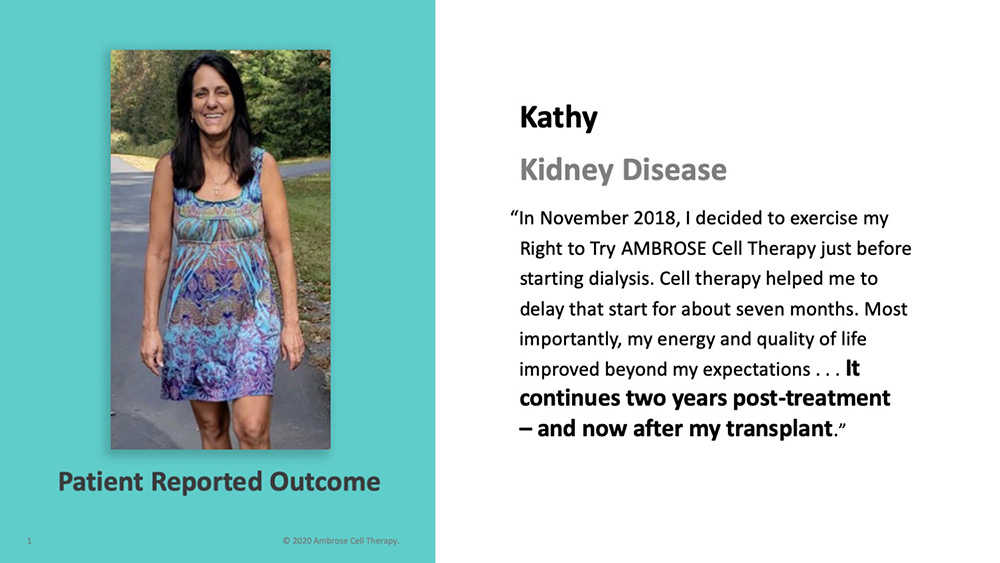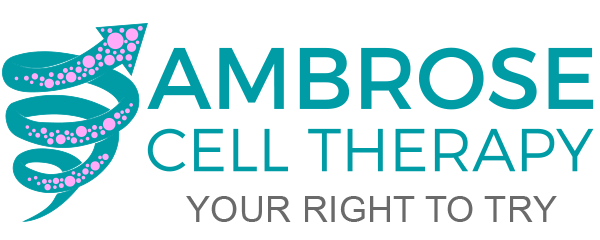If You Are Unique, Why are You Treated As an Average Patient
Kathy’s Patient-reported Outcome – Inherited Kidney Disease
“All happy families resemble one another, each unhappy family is unhappy in its own way.“
Leo Tolstoy
Like all patients with a chronic disease, Kathy was symptomatic in her own way. With 5% kidney function, regeneration was not an expectation. She faced a sure path to dialysis, to be followed by a kidney transplant. Kathy also had neck and hip pain. Just before starting dialysis, she exercised her Right to Try AMBROSE Cell Therapy.

Kathy’s patient-reported outcome provides a look at the unique benefits a patient can have by accessing one’s adipose (fat)-derived regenerative cells (ADRCs). Said differently, just as an individual’s symptoms differ, so are the improvements that can be achieved in one’s quality of life.
Our bodies are much the same as Tolstoy describes families. When we are healthy, we enjoy exercise, sleep well, and lead active lives. In health, we are all pretty much the same.
In contrast, a group of patients diagnosed with the same disease will have symptoms unique to each in their own way:
- Many patients diagnosed with Parkinson’s disease have tremors, but others do not.
- Heart disease may or may not include high blood pressure, irregular heart rhythms, hardening of the arteries, chest pain, or shortness of breath.
- Some patients have arthritis in one joint, and others have multiple joints that are stiff and painful – not to mention possible bowel or skin issues.
When we ask “Dr. Google,” What causes fatigue and dizziness? a top search result lists nine possible causes. Thus, diagnosis is problematic. Chronic conditions include different horns (symptoms) of the same devil (diagnosis). And different devils share many of the same horns.
As the Washington Post reported, Mayo Clinic found that more than 20 percent of patients are misdiagnosed by their primary care physician (PCP). But that is not because the PCPs do not meet Mayo’s standards. They get it wrong too.
The story goes on to explain, “Diagnosis is extremely hard,” said Mark L. Graber, a senior fellow at the research institute RTI International and founder of the Society to Improve Diagnosis in Medicine. “There are 10,000 diseases and only 200 to 300 symptoms.”
Mr. Graber’s stats help explain why there are so many disease spectrums. Our symptoms and how our bodies function (physiology) vary – even if we have the same diagnosis. Adding to the complexity, some patients have few if any symptoms, while others suffer badly with the same diagnostic findings. Most vexing, the degenerative process of one disease often leads to co-morbidities.
 The Epic Failure of Large Clinical Trials – Solving for the Average
The Epic Failure of Large Clinical Trials – Solving for the Average
Despite the uniqueness of our physical complaints, the standard of care relies on clinical trials with thousands of patients. The goal is to determine an experimental drug, device, or surgery’s safety and efficacy. That makes sense – at least on the surface. The trouble is that large trials “solve for the average,” but you are not an average patient. There is no such thing. Our unique differences in mind, body, family history, and lifestyle determine which devils and which horns with which we might suffer.
Personalized medicine is trying to solve for the individual. Here doctors:
- Use genetic testing to help determine the risk of inheriting a disease,
- Assess your gut for bad actors underlying a chronic condition,
- Evaluate inflammatory markers in your blood that may lead to heart disease, diabetes, or other illnesses, and so forth.
Though that approach is promising, little benefit for large populations has resulted from extensive testing. Why? Because doctors still rely on the standard of care, rather than personalized medicines, for prescribed treatments. Without personalized drugs, doctors have no choice but to solve for the average instead of the individual.
What does this mean in the real world?
In contrast to conventional medicines, ADRCs are unique to you. They are a personalized pharmacy residing in your body. Each cell in the ADRC population is in our blood, tissues, and organs, respectively. Their purpose in the body is to keep our bodily systems – vascular, immune, endocrine, and nervous systems – as well as our tissues in balance (homeostasis).
Admittedly, we can only make assumptions about why Kathy’s quality of life improved so much from AMBROSE Cell Therapy. Our thesis is that the IV of ADRCs brought her bodily systems toward homeostasis. The mechanisms may include, along with others, a systemic reduction in chronic inflammation and abnormal immune response aided by improved blood flow. Many other good things can result from such improvements. And the direct injections initiated a process of rescue and repair in Kathy’s neck and hip.[1][2]
At the end of the day, what matters most to Kathy is the improvement in her quality of life, despite the risk that it would worsen with dialysis and a kidney transplant.
[2] S. Kesten & J.K. Fraser Autologous Adipose Derived Regenerative Cells: A Platform for Therapeutic Applications Advanced Wound Healing SURGICAL TECHNOLOGY INTERNATIONAL XXIX
